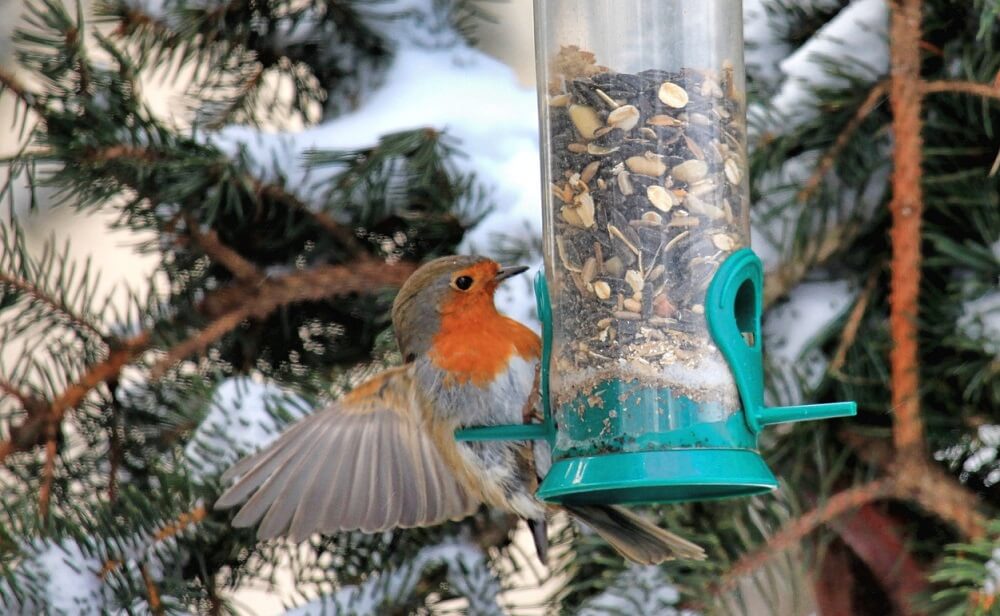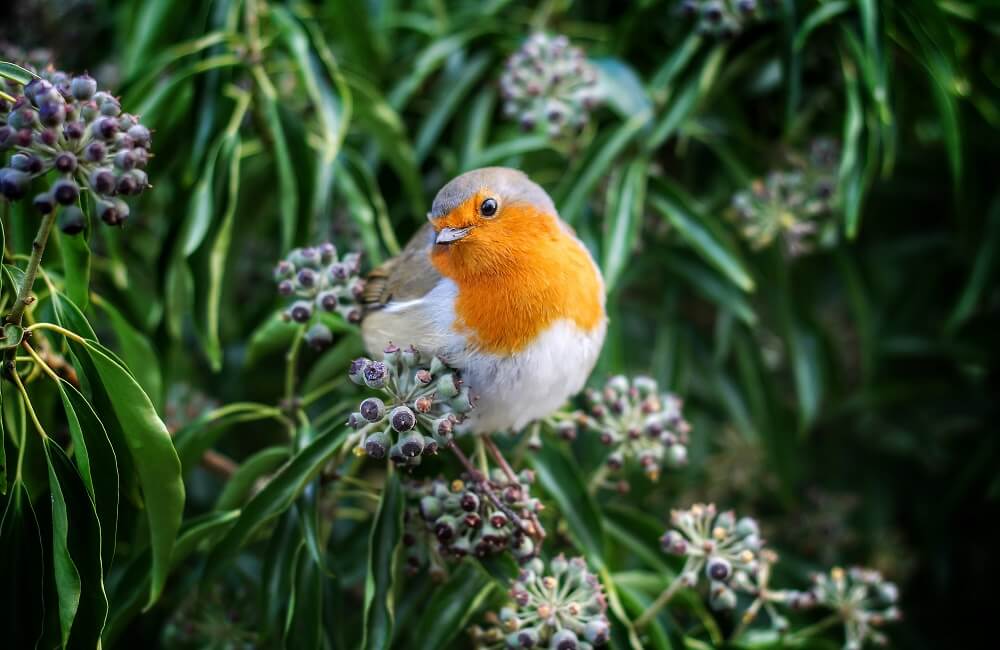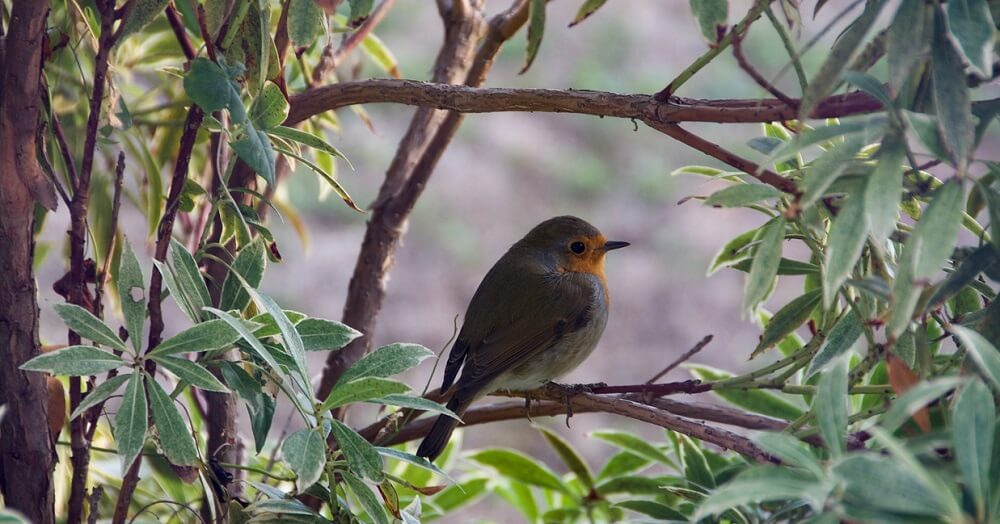Hopefully, you are enjoying our series on attracting wild birds. Be sure to check out part one on where to place bird feeders.
Robins are found across the world. Only Antarctica and South America are void of robbins.
We love them because they are often the winter singers chirping away during cold winter months.
But, robbins are probably in your garden all year round.
They are most noticed in the winter and early spring when they are the only birds singing away the day.
Only in the very north, such as Canada, do robins go south for the winter.
You can recognize a robin by its redbreast. Even the 45 species of robins in Australia have a variation of the distinguished redbreast.
If you want to attract robins to your yard and garden, there are several steps you can take.
1. Offer The Right Food For Robins
Robbins don’t eat regular birdseed. They leave it alone.
Instead, robbins are attracted to worms and fruit.
Robbins can eat a lot of worms.
Check this out!
Some scientists have said that robins eat 14 feet of earthworms day!
They need a lot of protein. You can offer protein to robbins in several forms.
- Earthworms
- Mealworms, dried or alive
- Crushed raw, unsalted peanuts
- Suet
- Low-sodium cheese
- Sunflower hearts (sunflower seeds without the husk)
- Chopped hard-boiled eggs
- Grasshoppers
There are a few things to know!
First, dried mealworms will be liked better by robbins if they are soaked in water before you offer them.
That way robbins can get some moisture value from the mealworms.
Also-
Don’t feed discolored, rotten, or bad mealworms to robins. That can make them sick and potentially kill them.
Second, although robbins will eat cheese, be careful about how much you feed them.
Cheese is high in salt and not very good for robbins.

Third, peanuts should never be salted or roasted. This isn’t healthy for the robbins.
Even roasting the peanuts without salt kills a lot of the beneficial nutrients that robbins need.
Robbins also love fruit.
Sugary fruits give robbins a boost of energy that they love later in the day and in the colder months.
You can offer a variety of sweet foods for robbins. Especially loved treats include:
- Chopped apples
- Raisins
- Watermelon
- Any berry: strawberry, serviceberry, huckleberry, hackleberry, Indian plum,
- Peaches
- Pears
- Any fruit!
It’s a good idea to keep a fairly constant supply of fruit in your robbin feeders all year round.
2. Feed Robins In An Open Dish
Robbins don’t like birdfeeders. It’s awkward for them.
They really aren’t built to perch on smaller perches. They also don’t like to break open seeds to eat them,
But,
On occasion, robbins that are hungry enough will find a way to use a birdfeeder, bumbling the entire time.
Did you know?
The best way to attract robins to your food is to use an open dish, a bird table, or a platter.
You can hang it, place it on your deck or porch, or add a bird table to your lawn.
Few other birds like open dish feasting so you are likely to attract mostly robins and finches.
Check out my favorite bird feeders here.
I like feeders that offer greater safety for robbins and are easy to use and durable. They have dome tops to protect robins from birds of prey.
They also offer good views so robbins don’t get surprised attacks from cats and other predators.
Where Is The Best Place To Hang A Robbin Feeder?
Hang robbin feeders in an area that offers a good view of the surrounding area. Place ground feeders close to bushes and other low shrubs that offer quick protection against cats and other predators.
The edge of a yard works well.
Don’t place feeders near fences or other structures that block the view and offer no protection for robbins.
Hanging feeders should be from plastic or metal posts that cats can’t climb. Feeders hung in trees allow cats to lay in wait for feeding robbins.
You can also hang your feeders to the side of a shed or a house.
3. Work With Robbins Feeding Schedules
Robins eat earthworms throughout the year.
They also love sweets.
Robbins will generally eat earthworms throughout the day and will go after fruit and other carbohydrates later in the day.
Know this:
Robbins usually prefer to forage during the warmer months. They may not eat worms from your feeder during the summer.
But they still like sweets.
They may prefer to snack on fruit in the summer, leaving the mealworms for live earthworms in your yard.
Winter makes it harder for them to find insects and worms so they are more likely to eat your mealworms.
Do this:
Test the robins in your area. Each climate is different and north borders may see robbins eating more in the summer than southern birders see.
Plus, microclimates make slightly different habits for these lovely birds.
Put out worms and fruit. See which food the robins eat.
Don’t forget!
Winter is especially harsh for all birds, especially heavy foraging birds.
Robbins are especially grateful for mealworms during the winter months. They also need the extra calories found in fruit in the colder months.
Remember to continue to set out food for your robbins in the winter.
It can mean the difference between survival and dying.
- Robins eat worms in the mornings and throughout the day
- They may prefer to forage for worms in the summer
- Robbins always love an afternoon snack of fruit
4. Offer Water And Mud
Robins need water like most birds.
But, mud is even more vital to them during the spring.
Why?
Female robins use mud to build their nests. A female will hatch 2 or 3 clutches each spring. She uses the same nests repeatedly.
Did you know?
A female robin may build several nests in a year before deciding where to raise her young.
She will often continue to return to older nests year after year and build a new nest on top of the older one.
Mud is vital.
If you live in an area that has wet springs, then it’s not critical that you offer mud.
But, a simple pie pan or dish with mud will be appreciated by your local robbins.
Water is critical to robin health.
They are hugely attracted to the sound of running water.
And-
Most people forget how important water is to robbins, and other cold-weather birds, in the winter.
Many times robins have to resort to eating snow for their hydration needs.
Offer water in the winter when the temperature is 10 degrees Fahrenheit or warmer (-12.2 Celsius).
If it’s too cold outside the evaporation off the water will cling to robbin’s feathers and freeze.
Robins need fresh water in the winter because it provides a way for them to bathe.
A dirty robin is a poorly insulated robin.
Feathers make great insulation as long as they are clean. Dirty feathers don’t keep the cold out well.
5. Plant Friendly Greenery In Your Yard
Encourage robbins to come to your yard without as much fuss from you by simply planting robin-friendly foliage in your yard.
Consider the two main needs of robbins: food and shelter.
Fruit trees, berry bushes, and other edible plants provide calorie-rich food to your landscape.
Some of the robbin’s favorite greenery include:
- Indian plum
- Thimbleberry
- Bitter cherry
- Blackberry
- Oregon grape
- Any fruit tree
- Crab apple (also used for nests)
- Pyracantha berries
- Chokecherries
Robins also prefer the twigs and branches from specific trees and bushes for building their homes.
Some of the best cover bushes include:
- Vine maple
- Current
- Ocean spray
- California wax myrtle
- Spindle bush
- Juniper
- Hackleberry
- Crabapple
- Evergreens
- Dead trees
Some of the robins in my yard love to nest in my crab apple tree. It provides safety and food closeby.
It also hangs a swing and my kids love it when the robbin daddy swoops down on them while they are playing.
Consider which trees will be dual purpose and provide some shelter and food sources for the robins in your area.
This is especially helpful when you have limited space.
6. Offer Safe Nesting Boxes
Robbins can be found in the city and the country.
Even if you have limited space, you can offer nesting boxes for your local robbins to encourage them to come by.
Did you know?
Robin nesting boxes are open. Robbins don’t like enclosed spaces like finches.
Instead, they like to build their nests on a platform or the fork of two tree branches.
A robin’s nesting box can be simple. An 8×8 inch square platform with a shelter or cover 8 inches above the platform is perfect.
Attach your nesting boxes to the side of your house or shed facing useful plants.
This will make it safer as cats won’t be able to climb to the nest.
Cats are the #1 killer of robbins.
Robbins generally nest about 10-20 feet above the ground.
7. Don’t Use Pesticides
Robbins forage and the widespread use of pesticides hurt them.
Consider carefully what you use on your lawn since robbins are probably eating the insects and worms out of it.
Don’t use pesticides.
If you must, then be selective about when you use them. Spray only specific weeds and be careful not to have extra runoff into the ground.
Conclusion
I hope you enjoy hosting robbins in your summer. If you’d like to learn more about where to place a suet feeder, check out the next article in this series.
Or, you might be interested in these related articles:
Where to Place a Bluebird Feeder
Where to Use An Oriole Bird Feeder
https://birdsna.org/Species-Account/bna/species/amerob/introduction




